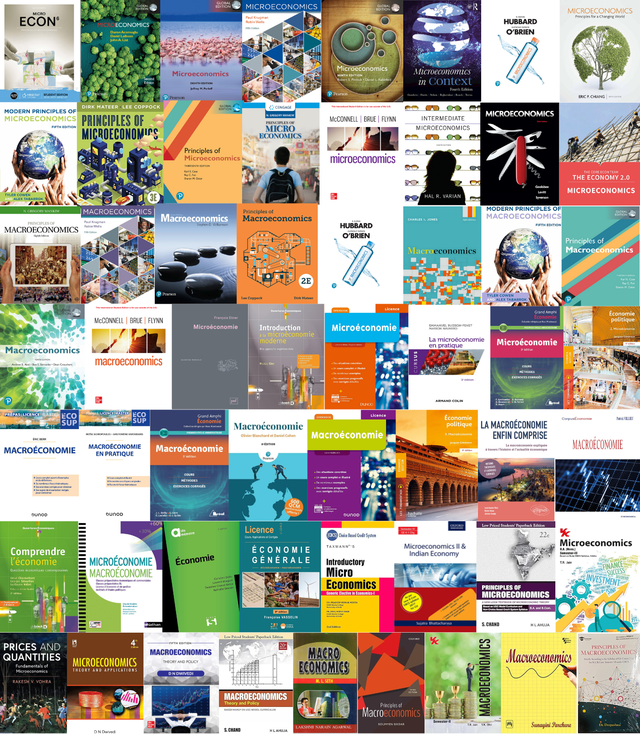- Home
- SUMMARY
- BY TEXTBOOK Apri sottomenù
-
BY TOPIC
Apri sottomenù
- S1 : Greenhouse effect
- S2 : Anthropogenic cause
- S3 : Future scenarios of temperature increases
- S4 : Impacts on Earth’s systems
- S5 : Impacts on economic and social systems
- E1 : Mitigation as a social dilemma
- E2 : Carbon pricing
- E3 : Discounting in reference to climate change
- E4 : Inequality in reference to climate change
- E5 : Social Cost of Carbon and IAMs
- E6 : Persistency & irreversibility in reference to climate change
- E7 : Climate decision-making under uncertainty
- E8 : Climate policies
- E9 : Behavioural issues in reference to climate change
- E10 : Adaptation and geoengineering
- SAMPLE LECTURE
- ABOUT US
Homepage
This website serves as a tool...
for undergraduate instructors and students who would like an introduction to the economics of climate change as part of the training. It documents the coverage of climate change in economics textbooks by presenting a comprehensive analysis of fifty-seven introductory textbooks. You will be able to download the parts of each textbook devoted to climate change.
This website is based on the research project initiated by Hugo Charmetant and Marco Casari, which led to the journal article: Charmetant, Hugo; Casari, Marco; Arvaniti, Maria, What do economists teach about climate change? An analysis of introductory economics textbooks, «Journal of Behavioral and Experimental Economics», 2024, 110, pp. 1 – 13.

WHICH BOOKS WERE SELECTED?
The selected textbooks were published or last revised in the years 2015–2024. We selected the textbooks that are widely adopted in introductory courses in undergraduate economics programs. We consider university entry-level textbooks for bachelor's degrees that were either introductory or intermediate but excluded those that are advanced. We included roughly the same number of microeconomics and macroeconomics textbooks (28 vs. 24, with 5 covering both).
We focused on textbooks written for US, French and Indian students. A textbook is considered US, French, or Indian if it was specifically written for that country. This means that the authors are affiliated with academic institutions in their respective countries, initially published their textbooks in the original language of that country or devoted some years as instructors in that country.
Our book selection samples three different continents, and focuses on countries that are either large, or with textbooks that have a broad outreach beyond their national borders, or both. For instance, US textbooks have been translated into many languages and are used in several countries outside the US. French textbooks can potentially be accessed by 321 million French speakers, as thirty-two states recognize French as an official language. Finally, India is the most populous country on the planet and its textbooks are widely distributed also in South and Southeast Asia.
OVERVIEW
A systematic analysis of how introductory economics textbooks cover climate change enables us to check whether climate change is treated as a mainstream topic within the economics profession and, more specifically, how much it is considered a basic, central economic problem versus a field topic for those specializing in environmental economics, or for the advanced students in an eligible class of the master program.
There is a wide difference between these views. The former regards climate change as a generational challenge that will involve a substantial portion of citizens and decision-makers, and its ubiquity requires a widespread awareness in order to face the inevitable economic challenges of mitigation and adaptation that lie ahead. The latter still considers climate change relevant for economists but views it as one of the many important applications of economic reasoning and policy, which will be eventually taken care of by a restricted group of experts designated to tackle the problem. It is, in a sense, orthogonal to the other economic problems, and not instead requiring a substantial re-alignment for most aspects of the society and the economy.
Simply bringing up the question has the potential to shape the beliefs of current economics students – who may become future policy-makers and researchers – about the centrality of climate change. While uncovering the causes of climate change has been the domain of natural sciences, tackling the problem requires the social sciences to get fully involved. An appropriate introduction to the issue will make the upcoming generation of economic and political leaders address it more effectively.
Overall, climate change is a marginal presence in all but a few textbooks. What Christine Lagard in her capacity of managing director of the International Monetary Fund called “the greatest economic challenge of the twenty-first century” obtains on average 0.55 % of space in a sample of 57 introductory textbooks that we have analysed from US, French, and Indian authors, with the majority of our best-selling sample devoting to climate change an average of one page or less out of 485 total pages.